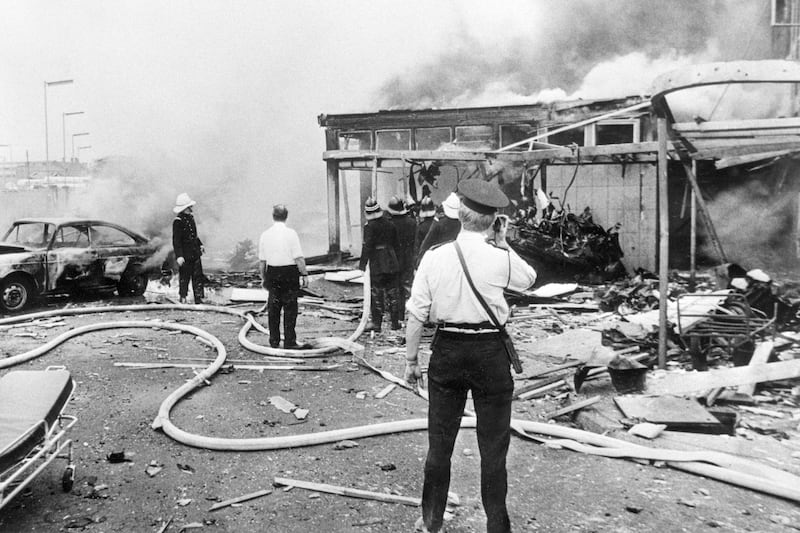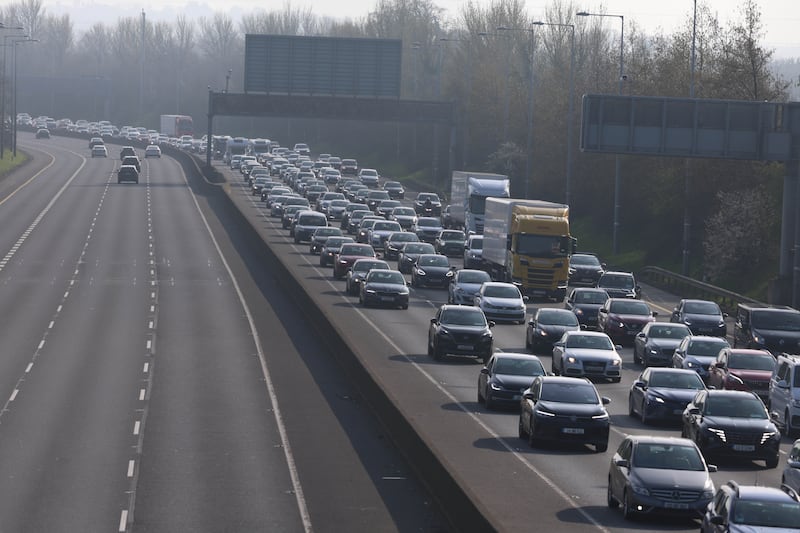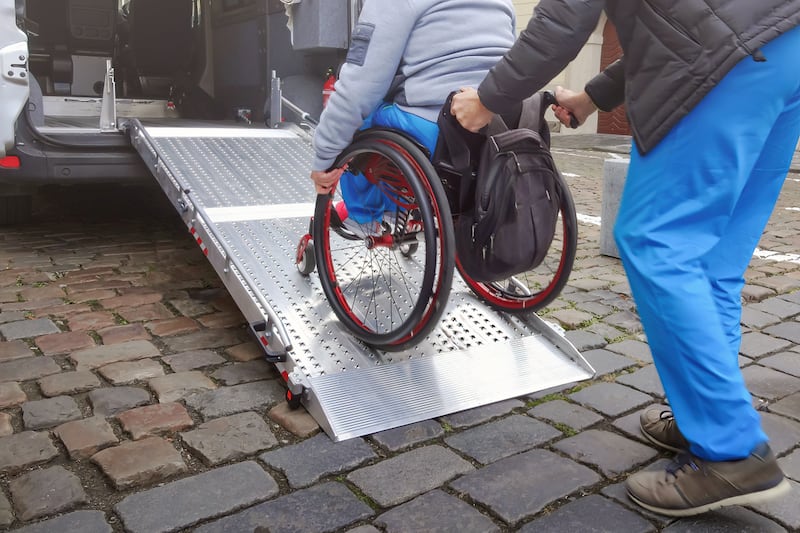Their shadows emerge from the dust cloud, above the raised concrete road. They arrive on the back of impossible choices about where to go and who to bring, sometimes bearing neither luggage nor documents. They are teachers and medics, engineers, factory workers and students. They are also witnesses to unspeakable horrors: rape, executions and bombings, humiliation and gnawing hunger. They have, occasionally multiple times, left everything they know to set out in search of a future.
Some travel on donkey carts, but more often they walk, bags in their arms or small children pulling on their hands. That day alone, 1,255 people would cross into South Sudan (1,679 the day before, 1,297 the day after, and 1,773 the day after that). Their numbers would be added to the more than 629,000 people who have come since Sudan’s war broke out.
“The gates of peace, welcome to South Sudan,” says a sign with Arabic lettering. Armed soldiers keep a wary watch. A few money exchangers swap currencies: one says he serves up to 30 customers a day, but “people have not a lot” with them, just “something for daily needs”.
[ South Sudan’s refugee crisis: ‘We’re missing our country, our place, our Ramadan’Opens in new window ]
Sudan’s war marks its first anniversary on April 15th. It is being called “the war the world forgot” by international media, but it’s never forgotten by the tens of millions affected by it. This violence has turned Africa’s third largest country into a hell. It has triggered what the UN dubs the “world’s largest displacement crisis”.
READ MORE
Inside Sudan, the UN says nine million people are displaced – at least two thirds of them since the war began. Almost five million people could face “catastrophic hunger” in the coming months, says UN humanitarian chief Martin Griffiths. Aid officials say there are enough food stocks inside the country, but it is not possible to transport them where they are needed. On March 8th, the UN Security Council called for a ceasefire, but that was not seen through.
More than 1.9 million people have fled the country, mostly to neighbouring states. In South Sudan, a country of roughly 11 million, it has triggered a mammoth repatriation effort. Around three-quarters of those crossing at the Joda border point are technically South Sudanese, though some have never set foot in the country. Others fled during the decades of fighting for independence, between 1955 and 2005, that led to an estimated million deaths, or the civil war that erupted in 2013, two years after independence.
One widow, travelling back, was accompanied by two children, a two-year-old boy and 12-year-old girl. “We have faced many challenges on the way here. Now we’re suffering from lack of food. We saw people who had been killed by fighting between the two forces. Air bombardment, open shooting. The journey was dangerous,” she said.
“My message to all of these humanitarian agencies [is that] you have to provide needs assistance. These people running have left most of their needs behind. They left most of their household furnishings. Currently movement is very difficult, especially for men... with women they rob their things and rape them but men, they kill them.”
South Sudan will be “safer, in terms of security, but hard to survive,” she predicted.
Everybody understands that this crisis is barrelling towards a point of no return
— Tom Periello, US special envoy to Sudan
Others arrive, they are registered, then moved on. Families sit on sandy ground in an area for “vulnerable” people – pregnant women, small children, those with special needs and the sick or injured. The UN-aligned International Organisation for Migration (IOM) is co-ordinating the travel. A staff member in a high-vis vest picks up a loudspeaker, a few sheets of printed paper in his left hand. He calls a name, then another. This group will ride in a bus.
Further away are the trucks. Women and children are loaded in first; men take the rear, pulling up a guardrail. The heatwave, with daily temperatures above 40 degrees Celsius, means numbers for each vehicle are down to 120 from 200 “to give them more space”, an IOM staff member said. In total, 940 people would be taken away in trucks that day.
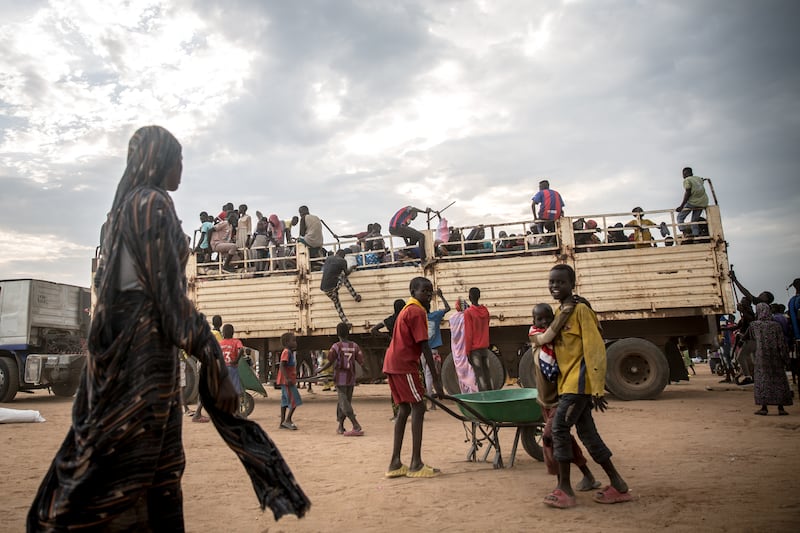
For space reasons, only “handbags” and soft mattresses were allowed as luggage, he said – “a family of seven can take one sack maybe”. Some people arrived with fridges which had to be abandoned, he added. Others carried solar panels, though these were usually confiscated on the Sudanese side. Many were almost empty-handed. “It is nature,” said a Save the Children aid worker, who had lived as a refugee too. “When we ran to Sudan from the war here we carried nothing.”
James Ngor, a 21-year-old travelling with nine family members, said he was trying to sell a bed and saucepans that they were barred from taking further. They needed the money. Escapees were constantly robbed at checkpoints before they left Sudan: “telephones, valuable items, even money” taken, he said. They managed to keep one phone, but there was no reception, meaning the family members they were trying to reunite with had no idea they were coming.
Samia Ibrahim, 50, had come from Omdurman, a city beside Sudanese capital Khartoum. She was seeing South Sudan for the first time. “Khartoum is very bad, no food, no medicine, people want to come here but they can’t,” she said.
A 17-year-old, her sister’s baby in her arms, left Sudan’s White Nile State. “What happened in Sudan is very unfortunate but we just have to be patient and find a way through,” she says stoically.
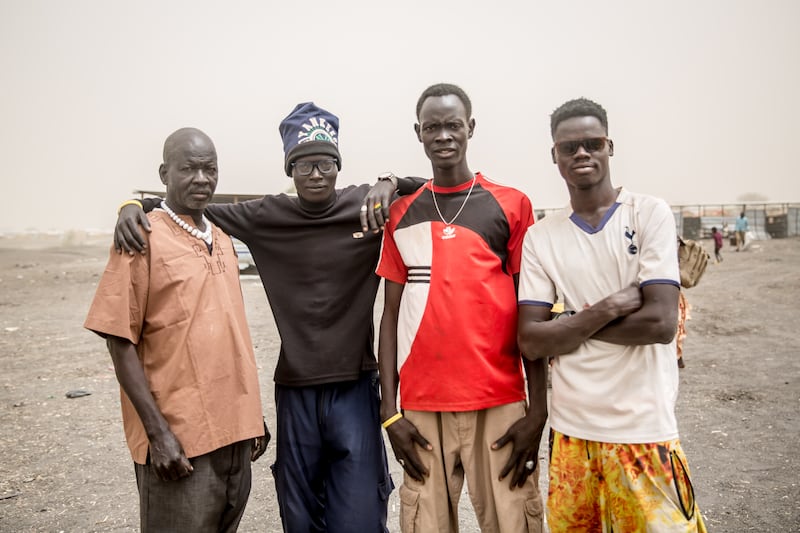
Displacement means a lot of things. It means education disrupted, family members missing, shattered communities that will never be repaired. It means not feeling secure any more, wherever you are. It means conceding that your fate is no longer in your hands. It means a lot of discussion over which location is best, which country is welcoming. Where can people work, where can children study, where can they access healthcare?
Many flee without a final destination in mind; they are conscious that anywhere, existence can be gruelling and comes with no security. They know they may have to try and try again.
Two transit camps, known as TC1 and TC2, have been set up in Renk, around 40km south of the border with Sudan. Nearly 20,000 people live across them. The first is on the site of a former university, disused since war broke out here. “People ran from this place to Khartoum, and now they’re running from Khartoum to this side,” said one former refugee working for an aid agency. “When they first came this place was a forest,” she gestured around.
They are designed for people to stay only two weeks, before they move elsewhere in South Sudan, if South Sudanese, or to a remote refugee camp, if they are not. But many end up staying longer, with no idea what to do or where to go, reluctant to be parted from the international organisations they think might help them. A lack of food aid provisions means they go hungry.
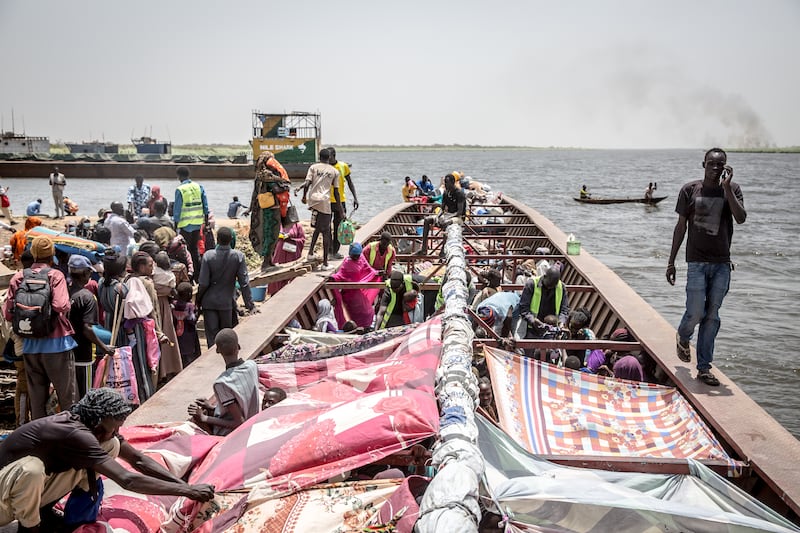
As in every refugee camp, small businesses have sprang up. There are people selling clothes, soap and other hygiene items, and even some wifi cafes, which operate through Starlink satellite connections. Internet is too expensive for most, at around 1,000 South Sudanese pounds (55c) per hour. Even when customers connect, they’re well aware that the war in Sudan is also a war on communication, with both sides shutting down data and mobile connections, thus preventing loved ones from making contact.
Close to collapse
Sitting on a mat, chatting to pass time, is Mouner Oumarou Saddam. The 29-year-old comes from Central African Republic (CAR), a former French colony. His story is another reminder Sudan is far from the continent’s only crisis. A civil war in CAR, beginning in 2013, propelled a humanitarian situation where nearly 8 per cent of newborns die before their first birthday; 10 per cent by the age of five. Saddam’s child is on his lap; his wife sits beside their piled-up belongings nearby. They arrived the previous day. The former aid worker, and information technology graduate, stayed a decade in Sudan. He was considering travelling to Uganda next, so he could pursue a resettlement case with UNHCR, in the hope his family would eventually be moved to a Western country. “Is this the life that was destined for us?” he asked. “I’m looking for peace. I’m looking for a place my children can study.”
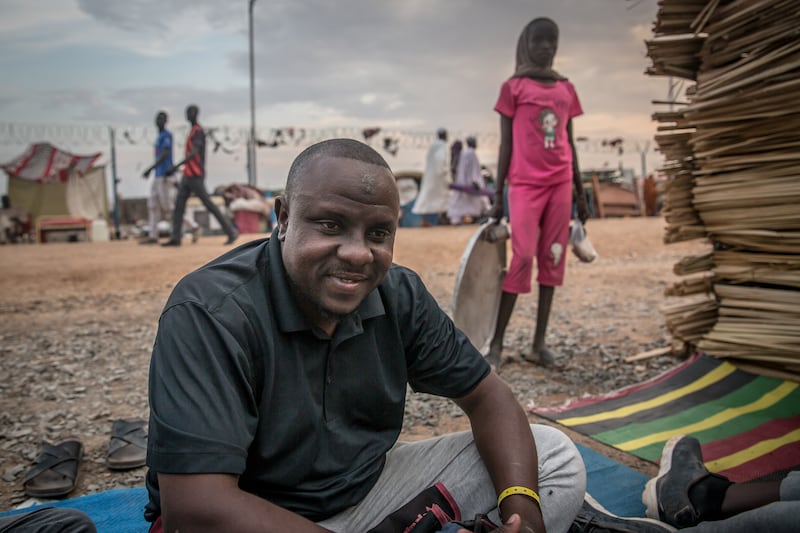
Albino Akol Atak Mayom, South Sudan’s minister of humanitarian affairs and disaster management, says the government has maintained an “open-door policy” for the past year, “because people are running from war, they deserve to be protected, they deserve to be helped”. He said North and South Sudan’s history as one country meant citizens from both sides historically used the other to find safety. Anyone can cross the border without documentation, he confirmed, “because we know the situation”. Their “only intention”, he said, “is actually to rescue”.
South Sudan’s local authorities are doing what they can and the government has made a commitment to “continue supporting these people”, but they need help from international “partners and donors”, particularly when it comes to funding, he said. “The conflict found us unprepared, so there is not sufficient funds”. Even those who are originally South Sudanese return to “no houses ... nowhere to stay” and need “food, medicines, even schooling”.
“We are addressing it as an emergency and an emergency needs the hands of everybody,” he appealed, warning about potential implications if help is not forthcoming.
How will one of the world’s most fragile states bear yet another calamity? South Sudan has many worrying designations. For the past decade, it has been ranked within the four most fragile states globally by American non-profit the Fund for Peace, which assesses how close states are to collapse. Transparency International’s Corruption Perceptions Index puts it among the most corrupt countries globally. Last year, a UN report named it the most dangerous country for aid workers.
It’s also facing an economic crisis, with prices and inflation soaring. The most recent shock was caused by the shutdown of a pipeline, running through Sudan, on which oil-rich South Sudan is dependent.
Meanwhile, less than 6 per cent of what the UN says is needed in Sudan for 2024 has been raised – $159.7 million of nearly $2.7 billion. Ireland is the eighth largest listed donor, at $7.25 million (€6.67 million), funding which comes aside from contributions through the higher listed EU and the UN’s Central Emergency Response Fund. In early April, the South Sudan humanitarian response plan was 19.1 per cent funded, with $342.1 million of the $1.79 billion the UN says is needed. Some $4.8 million of that comes from Ireland.
In a press conference in Juba in March, Inger Ashing, the chief executive of international humanitarian organisation Save the Children, called South Sudan “one of the most underrepresented crises globally” where “the needs” and “gaps are enormous”. Despite the severity of other current crises, she said, we “cannot turn our back”.
“Simply put, we are failing the people of Sudan,” Edem Wosornu, the director of operations at the UN’s humanitarian office, told a UN Security Council meeting last month, calling the war a “humanitarian travesty”.
“Everybody understands that this crisis is barrelling towards a point of no return,” Tom Periello, US special envoy to Sudan, said in February.
At the mercy of power-hungry men
In Renk hospital, medical director Ayuel lual Ayuel said they see hundreds of patients a day, many of them malnourished children. Staff charts show that at least 60 have died. New mothers are sometimes too malnourished to breastfeed, Ayuel said. Rainy season is expected to bring more cases of malaria, diarrhoea and gastroenteritis. He said the hospital lacks testing facilities. People with chronic conditions – cancer patients needing chemotherapy, or diabetics needing insulin – can’t get what they need. There is limited treatment for bullet wounds, or people with crushing injuries from buildings falling on them.
In one ward sits a stunned-looking woman, who asks not to be named. She travelled hundreds of kilometres over three days to bring her four-year-old son here: he was the sole survivor from a car crash, where militants ran a vehicle into nine children in a displacement camp in Sudan. It happened when the “wrong elements” ousted the Sudanese army, and “attacked us, shooting, moving around and showcasing their strength”. The boy’s leg seemed broken in two places; a makeshift splint held it together. He needed an X-ray but “the person in charge has closed the office and gone to attend to other emergencies,” she says.
“This is now my home,” she continues, her voice resigned. She has nowhere else to go. Her husband was still in Khartoum; her previous husband was killed at the beginning of South Sudan’s civil war. She was considering travelling to Juba – roughly 800km away – to find her husband’s father.
In the next ward, a slim 20-year-old man lay on his back, hands on his chest and his face contorted in pain. He was caring for his goats when he was stabbed by another herder, wanting to graze cattle on the same land. The influx of people from Sudan has led to competition over resources, he explains.
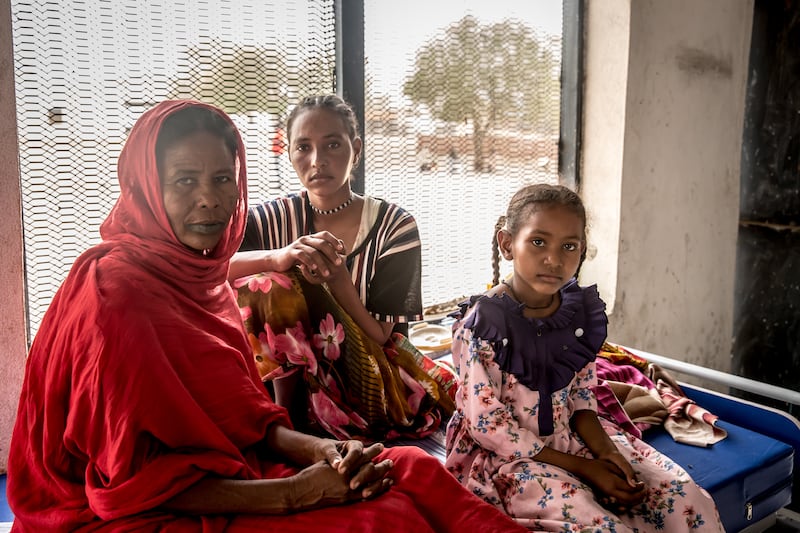
Keeping watch from a bed across from him were his mother, Haji Hessin, 48, and two sisters. Hessin said many men from their extended family work in Sudan for economic reasons, while the women and children stay close by. “It’s hard for us especially getting hard news, yesterday we heard one of our relatives was killed.” She said the family are originally Sudanese too, but they feel welcome here – “in the morning everyone will greet you” – though they struggle, like everyone else, from a lack of money.
Discussion turned to how Sudan’s war might end. “We have two people who want to be president, so we need them to sit down together or peace will not come,” says Hessin’s older daughter, 22-year-old Aida.
It feels like civilians of these two countries are constantly at the mercy of power-hungry men. South Sudan is still led by president Salva Kiir and vice-president Riek Machar, whose fallout, in 2013, sparked a civil war leading to an estimated 382,000 deaths by 2018. A powersharing agreement, signed that same year, has not brought an end to violent instability. The UN Refugee Agency still calls it “Africa’s largest refugee crisis”.
Sudan’s current war is also a battle between two men: Abdul Fattah al-Burhan, head of the Sudanese army, and Mohamed Dagalo, or Hemedti, who commands the Rapid Support Forces (RSF). Their 2021 joint power-grab dashed hopes Sudan’s pro-democracy activists had for civilian rule, following the jubilant ousting of Omar al-Bashir in April 2019. The generals’ subsequent fallout has devastated the country. Sudanese activists are now reduced to begging a distracted world for attention. That desperation is evident in the commonly-used hashtag #KeepEyesonSudan.
Civilians in both Sudan and South Sudan know well that war kills in many ways: not just through bombs and bullets, but through farmlands that go unplanted, unchecked disease, blocked aid supplies and gnawing hunger.
Displacement has immeasurable impacts too. It means education disrupted, documents lost, family members missing, businesses and careers demolished. It means starting all over again, sometimes multiple times. It means trauma, never feeling secure, and a realisation that your fate is no longer in your hands. It means a loss of faith in institutions, international bodies and the rule of law.
The silent partner of movement is agonising waiting. Waiting for food rations or small cash handouts, for medical care or transport. Waiting to see if a ceasefire might be called and to find out the fate of the missing. Waiting to see if there’s any hope, and waiting for the moment that hope is dashed again.
Human cargo
In Renk, from the early morning, they wait. Into a truck again, and out at the riverside. There, they are packed hundreds into a single boat, and sent on a two- or three-day odyssey to Malakal, more than 300km along the White Nile. Much of South Sudan, including this region, is not well connected by road – a legacy of war and underdevelopment. The same journey takes 40 minutes by plane, a trip humanitarian workers do regularly. These boats used to transport the sorghum crop, crew said, before they switched to this human cargo.
Returnees line up beside a disused tank, a war remnant. A woman in a wheelchair is hoisted up a ramp, and into the boat. Another woman, 27-year-old Sekina Yusuf, is travelling with her five children and three sisters – hoping to be reunited with their mother. It would be her first boat journey, and she was worried about getting sick. She felt a deep sadness too: her husband disappeared during fighting four months ago and she has heard nothing since. “Now in Sudan there’s no network, so no way to contact him. We ran when the war came. There’s no way for communication, no Facebook, no phone calls, no way to reach him.” Her husband had previously spoken about going to South Sudan, so she still hoped for reunification. Yusuf holds her youngest boy on her lap. “He’s three months old,” she says. “My husband has not met him.”
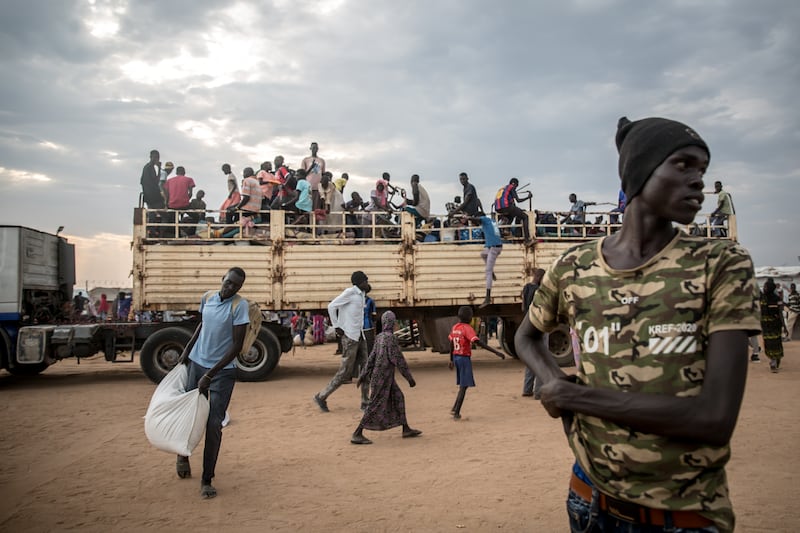
Awtaf Omer Mohammed (38) was also contemplating her past choices. She was en route to be reunited with her husband in Wau, hundreds of kilometres southwest, along with her aunt and two children. But she had left her other children with her sister in Khartoum. Without any way to communicate, she had no idea how they were doing.
“I had no money to bring all the children, even the transport was so expensive. I hope soon we’ll be reunited but the problem is that we don’t have cash. I have no way to send money now but I’m hoping my husband can send money later on.”
The first hundred were in. They began tying scarves overhead, offering some relief from the scorching sun. In the bridge, one captain’s assistant was taking selfies, the other chatting. He says his dream is to return to education and study English. When I asked if he meant in university he said no, primary school. He is 22, his lack of formal learning another casualty of this region’s long wars.
Three boats were scheduled to leave Renk that day, carrying between 1,200 and 1,500 people. More than 100,000 have made the same journey over the past year. Ongoing violence, even here in South Sudan, mean they have been caught in the middle of crossfire before. But Malakal is a transport hub. From there, these passengers can travel onwards.
What kind of future awaits them?
- Join us for The Irish Times Inside Politics podcast live in Belfast on April 10th
- Sign up for push alerts and have the best news, analysis and comment delivered directly to your phone
- Find The Irish Times on WhatsApp and stay up to date














